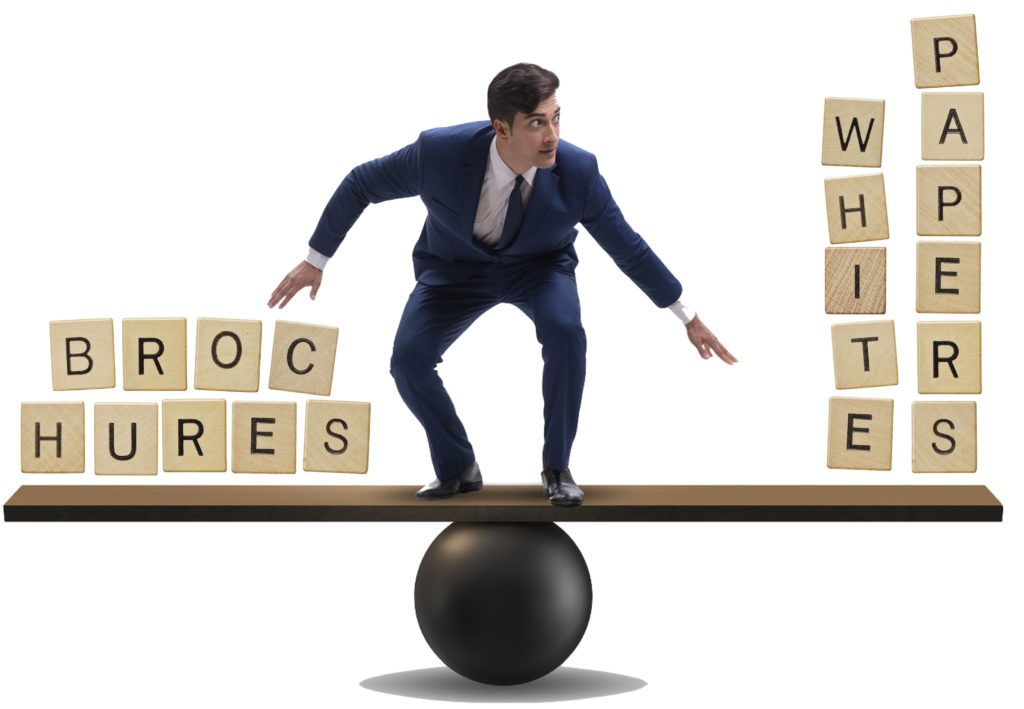White Paper Planning
White papers versus press releases
If a client asks for “an announcement” what do they really want? In most cases, they’re after a press release. Press releases are short, factual announcements intended to share some news from a certain company. This format has existed for more than 100 years. The first press release is generally considered to date from 1906.…
Read MoreWhite papers versus case studies
Many people are not clear on the differences between white papers and case studies. B2B copywriters and marketers must understand when to use each one. After many years, I’ve come to the conclusion that white papers and case studies are the two most powerful, most convincing, and most cost-effective marketing materials that any B2B vendor can…
Read MoreWhite papers versus brochures
White papers and brochures are almost complete opposites. Here’s why. Back in the day, every B2B vendor printed up glossy brochures for every major product. These were handed out at trade shows, left behind after sales calls, and even mailed out to prospects: all to create interest and desire. An effective brochure pushed “emotional buttons”…
Read MoreWhite papers versus blog posts
Most people can tell the difference between a white paper and a blog post. For starters, one is longer and the other is shorter. For another, a blog post is another item on an existing blog, while a white paper is a standalone PDF you can download. Beyond that, a good white paper is based…
Read MoreInclude a buyer’s guide (part 4 of 4)
Part 3 of this article covered how to describe your recommended solution in generic terms. This goes a long way to persuading your reader using well-informed logic. Now it’s time to finish the job, with a buyer’s guide. A buyer’s guide is a short set of bullets that list what to look for in an ideal…
Read MoreRecommend a generic solution (part 3 of 4)
Part 2 of this article discussed how to destroy the credibility of every other way of dealing with a widespread problem. Now you can sweep them all out of the way with your new, improved, recommended solution. And you can do it without a sales pitch. Introduce your solution… generically Don’t jump in and label it…
Read MoreDemolish the competition (part 2 of 4)
Part 1 of this series discussed how to frame a white paper around a nasty industry problem. This builds rapport with your reader, holds their attention, and creates urgency. Next, you must destroy the credibility of everyone else’s way of dealing with that problem. Here’s how to do that. Step #1: List every alternative Include anything…
Read MoreFrame your white paper around a nasty problem (part 1 of 4)
In your next white paper, why not go back to square one? Why not start by describing the problem your offering was designed to solve? “It’s often effective to start by describing a predicament experienced by your target market,” agrees Marcia Yudkin in a recent edition of her Marketing Minute newsletter. “This creates rapport and sets…
Read MoreHow to plan a product backgrounder
Once upon a time, every white paper was a product backgrounder. A backgrounder is good for explaining an unfamiliar or misunderstood product to a technical audience. For a prospect at the end of the sales cycle, or to back up a product launch, a backgrounder can be powerful. These documents do have shortcomings. Unless your…
Read MoreHow to plan a numbered list
A numbered list is the fastest and easiest flavor of white paper to create. And it’s the easiest to place in a trade magazine or website, or to repurpose as a blog post. Readers love numbered lists because they’re light and lively, short and simple. For a vendor, a numbered list is a good way…
Read More



